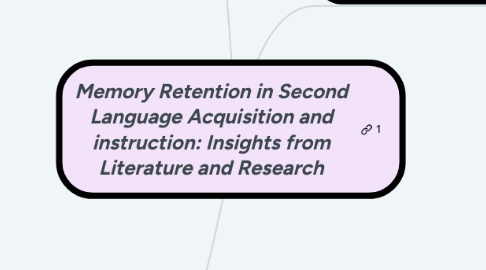
1. Issues of memory retention
1.1. Attention and Awareness
1.1.1. Attended learning is far more superior, important and necessary of practical purposes in SLA
1.1.2. Preparatory attention and voluntary orienting vastly improves encoding.
1.1.3. Passiveapproach leads to slow and unsuccessful language learning
1.2. Implicit and Explicit Language Learning and Knowledge
1.2.1. Nature of implicit learning
1.2.1.1. DEFINITION: Acquisition of knowledge by a learning process that takes place naturally
1.2.1.2. domain free inductive process
1.2.1.3. at least partly tacit and unavailable to conscious introspection
1.2.1.4. Noticing, comparing and integrating
1.2.1.4.1. corrective actions
1.2.1.4.2. continuous communicative practice
1.2.1.4.3. confronting mismatched between flawed and model performance
1.2.1.4.4. retrials
1.2.2. Role of explicit knowldege
1.2.2.1. DEFINITION: Conscious operation of learning
1.2.2.2. how learners develop ability to use language and pragmatic knowledge in production (Ellis, 1994)
1.2.2.3. e (noticing, comparing and integrating)
1.2.2.4. stages: 1. input becomes intake through noticing and comparing. 2. intake becomes part of the learners' interlanguage system.
1.2.2.5. success in L2 learning depends on implicit knowledge
1.2.2.6. Controlled and constant grammar practice
1.2.2.6.1. problem solving
1.2.2.6.2. Memorisation
1.2.2.6.3. Inductive and deductive approach
1.2.2.7. lack of comprehension + gap in knowledge = misunderstanding (aids learning)
1.2.2.8. (Ellis, 1994), pay close attention to input - central role in language pedagogy and formal instruction - facilitate implicit knowledge (role of explicit knowledge)
1.2.2.9. (Jensen) vocab = meaning from context = good index of intelligence (Stenberg) vocab = learn + do (experience)
1.2.3. Conclusion: motivation + reading (implicit) aided by elaborative, explicit process of semantic.
1.2.4. Tasks and rules
1.2.4.1. complex rules (implicit)
1.2.4.2. simple and salient (explicit)
2. Memory Retention in SLA
2.1. Fundamentals od Human Learning and Memory
2.1.1. retention + acquisition
2.1.2. Information-processing approach
2.1.2.1. separate storage models
2.1.2.1.1. information --> primary memory (short term memory) --> secondary memory (long-term memory)
2.1.2.1.2. metacognition helps
2.1.2.2. semantic network models
2.1.2.2.1. levels of processing approach
2.1.2.2.2. knowledge is stored through multiple interconnected associations, relationship or pathways
2.2. Memory in Second Language Learning
2.2.1. Working Memory
2.2.1.1. Regulate info flow within the working memory.
2.2.2. Constructivist approach (inductive reasoning)
2.2.2.1. General process of human inductive reasoning lead to language learning.
2.2.3. From the structure of adult language (not from genes)
2.2.4. Chunking
2.2.4.1. Combine chunks of memory to a larger unit.
3. Second Language Instruction for memory retention
3.1. Learning and Teaching Principles
3.1.1. Incidental versus Intentional Learning
3.1.1.1. Issues
3.1.1.1.1. quality of information processing of unfamiliar words
3.1.1.1.2. quantity and quality of rehearsal activities
3.1.1.1.3. training of automatic access to word knowledge
3.1.1.2. lexical knowledge
3.1.1.2.1. functional archi-style model
3.1.1.2.2. connectionist model
3.1.1.3. quality and frequency if info process activities
3.1.1.4. incidental vs intentional (tell vs not tell)
3.1.1.5. Distributed practices (correct retrieval) is better than mass practices. (no over learning)
3.1.1.6. reader should apply decontextualization skills and write down lexical info during reading.
3.1.1.7. new info reactivated (short intervals - monthly intervals)
3.1.1.8. high frequency word (familiar) i-1 level
3.1.1.9. intentional complementary with incidental & context.
3.1.2. Task-induced involvement construct
3.1.2.1. Search
3.1.2.1.1. cognitive dimension
3.1.2.1.2. attempt to find the meaning of unknown L2 words from
3.1.2.2. Need
3.1.2.2.1. motivational dimension
3.1.2.2.2. based on drive to comply with task requirements
3.1.2.3. Evaluation
3.1.2.3.1. cognitive dimension
3.1.2.3.2. compare given word/ specific meaning with other words/meaning
3.1.2.4. Assumption
3.1.2.4.1. higher involvement load, better retention of words
3.2. Instructional Approaches
3.2.1. Incidental Vocabulary Learning
3.2.1.1. Vygotskian Activity Theory
3.2.1.1.1. material constructed with
3.2.1.2. Generative & Communicative task
3.2.1.2.1. more background knowledge, better performance
3.2.1.2.2. higher level of generation, more vocabulary knowledge gain
3.2.1.3. role of modified input & output
3.2.1.3.1. modified output group scored higher on comprehension of directions, vocabulary, recognition & production
3.2.1.3.2. negotiation of new vocabulary in collaborative & problem solving manner, deeper input processing
3.2.1.4. input, output, task
3.2.2. Grammar Processing Instruction
3.2.2.1. explicit focus on form
3.2.2.2. intake by explaining , practicing & experiencing input data
3.2.2.3. simultaneous processing is difficult
3.2.3. Focus on Form Method
3.2.3.1. incidental & prerequisite engagement in meaning before attention to linguistic features can be expected to be effective
3.2.3.2. effective in communicative content-based classroom
